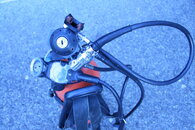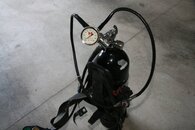Nemrod, that is not a good “test” of the performance of the first stage. The change which added the top port occurred when the U.S. Navy Experimental Diving Unit tested two different Scubapro first stages (Mk 5 against I think the Mk 2) and found the less expensive one performed better at depth. The Mk 2, if my memory is correct, had only the port on top, but out-performed its more expensive brother.You should take a Scubapro regulator(s) and then afix them to identical tanks at exactly the same pressure, one with a hose on the top port and one with the hose on a side port. Turn the tanks full on and then time the bleed down. Spoiler alert, it will be hardly any different. And while on the subject, I do not see any significant difference in IP drop between a side port and top port.
I have also run three IP gages on a first stage, a Mk 10. One on the turret side port, one inline with the hose at the first stage and a third in line at the second stage. Spoiler alert, the longer the hose the more the drop or Delta between the gages. And, IMO, the Delta is not significant in use with a properly tuned first stage, short or long hose.
The top port is a good thing in that it allows options for hose routing, especially for twin tanks but increased flow is minimal.
SeaRat












